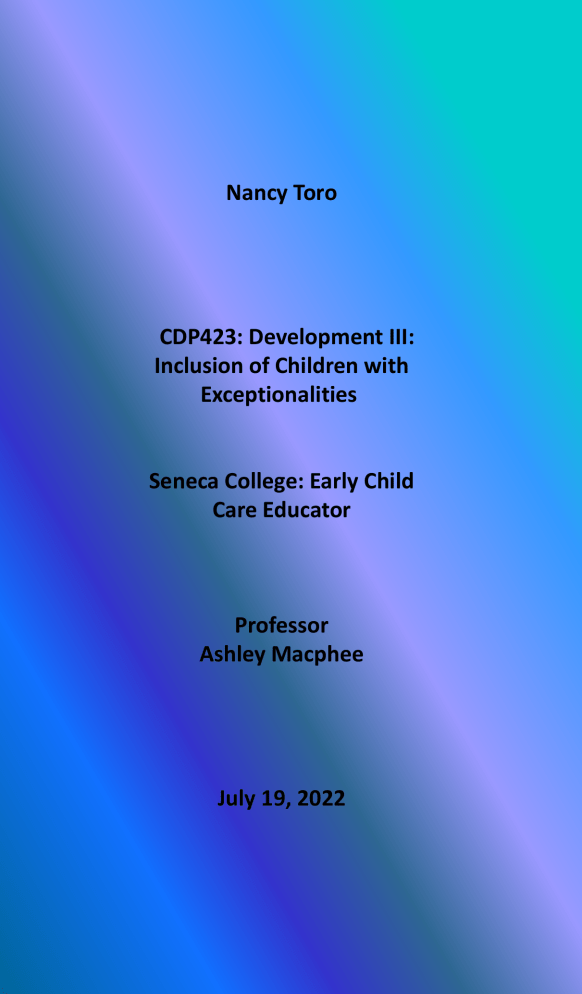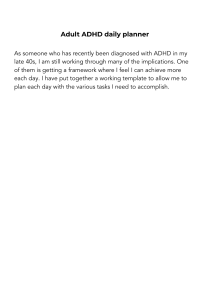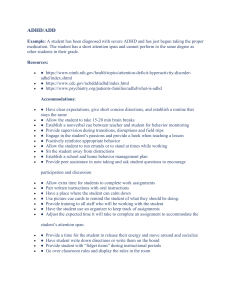
Nancy Toro CDP423: Development III: Inclusion of Children with Exceptionalities Seneca College: Early Child Care Educator Professor Ashley Macphee July 19, 2022 Attention Deficit Hyperactivity Disorder Definition of ADHD: is considered a chronic and debilitating disorder and is known to impact the individual in many aspects of their life. Symptoms of ADHD include inattention , hyperactivity and impulsivity (APA, 2022). Behavioral and physical characteristics Many children may have difficulties sitting still, waiting their turn, paying attention, being fidgety, and acting impulsively (APA, 2022). Causes - genetics contribute to ADHD and several genes have been linked to the disorder. -There is evidence of anatomical differences in the brains of children with ADHD in comparison to other children without the condition. For instance, children with ADHD have reduced grey and white brain matter volume and demonstrate different brain region activation during certain tasks. -Several non-genetic factors have also been linked to the disorder such as low birth weight, premature birth, exposure to toxins (alcohol, smoking, lead, etc.) during pregnancy, and extreme stress during pregnancy (APA, 2022). Signs for an Educator to be aware of A diagnosis is based on the presence of persistent symptoms that have occurred over a period of time and are noticeable over the past six months. The symptoms must be present before the individual is 12 years old and must have caused difficulties in more than one setting. For instance, the symptoms can not only occur at home. (APA, 2022). Inattentive Symptoms of ADHD: Makes careless mistakes in schoolwork, overlooks details Is easily distracted or sidetracked. Has difficulty following instructions Doesn’t seem to be listening when spoken to directly Has trouble organizing tasks and possessions Often fails to finish work in school or chores in the classroom Often avoids or resists tasks that require sustained mental effort, including doing homework (APA, 2022). Hyperactive or Impulsive Symptoms of ADHD: Often fidgets or squirms. Has trouble staying in his seat Runs and climbs where it’s inappropriate. Has trouble playing quietly Is extremely impatient, can’t wait for his turn. Talks excessively Always seems to be “on the go” or “driven by a motor” Blurts out answers before a question is completed Interrupts or intrudes on others’ conversations, activities, possessions (APA, 2022). The impact the ADHD could have on the child’s overall development. They may develop poor self-esteem, they’ll continue to have trouble interacting with others. Also they will have conduct disorders, learning disabilities, anxiety, autism, and mood disorders. Treatment can help avoid some of these issues, especially when it’s started early (Raspolich, 2022). learning The barriers of learning and socio-emotional interactions. ADHD have difficulty concentrating can start to fall behind other students in their schooling. Completing tasks on time can become very difficult. It can start to cause grades to fall, and children with ADHD may get into more and more trouble for causing class disturbances. As a child begins to isolate themselves from their peers, it may cause them to be more antisocial, aggressive, or depressed (Raspolich, 2022). organization socioemotional interactions Children with ADHD can have difficulty making friends. they can be impulsive and hyperactive. It is hard for them to maintain friendships. they are often emotionally immature. If ADHD has emotional outbursts or have aggressive tendencies, have trouble getting along with their peers. Children with ADHD do tend to do better in small, structured environments. Emotional maturity process can be slower in people with ADHD. Also suffer from low self-esteem (Bailey, 2007). CHADD CHADD offers a Teacher Training Program crafted by teachers to provide other teachers with the strategies and tips to help their students with ADHD succeed. In addition, CHADD's National Resource Center on ADHD has produced a video series of Tips for Teachers (CHADD, 2022). They offer on the Educators Classroom Accommodations, Instructional Process. Assignment Accommodations, Educational rights, Teacher Training & Webinars for Early Video Series, Childhood Teacher to Educators. Teacher. References: 1. Pictures: Barrier created by Enginer, G from Noun Project: https://thenounproject.com/icon/barrier-1343507/ Child climbing playground created by Lay, K, G from Noun Project: https://thenounproject.com/icon/child-climbingplayground-2751442/ Distracted created by Chattapat from Noun Project: https://thenounproject.com/icon/distracted-3426579/ Helping created by Kostl, M from Noun Project: https://thenounproject.com/icon/helping-3427273/ Naughty child running created by Lay, K, G from Noun Project: https://thenounproject.com/icon/naughty-childrunning-2739687/ Question created by Muttaqin, A from Noun Project: https://thenounproject.com/icon/question-4827269/ Risk created by Studio, A from Noun Project: https://thenounproject.com/icon/risk-4283073/ 2. Web Page: APA. (2022). What is ADHD? American Psychiatric Association. Relieved from https://www.psychiatry.org/patients-families/adhd/what-isadhd#section_4 Bailey, E. (2007, August 30). How ADHD Impacts the Daily Life of a Child. HealthCentral. Relieved form https://www.healthcentral.com/article/how-adhd-impactsthe-daily-life-of-a-child CHADD. (2022). Professional development for K-12 educators. Relieved from https://chadd.org/ Raspolich, J. (2022).How ADHD affects child development and learning. Vista Pines Health Relieved form https://vistapineshealth.com/treatment/adhd/affects-childdevelopment/





